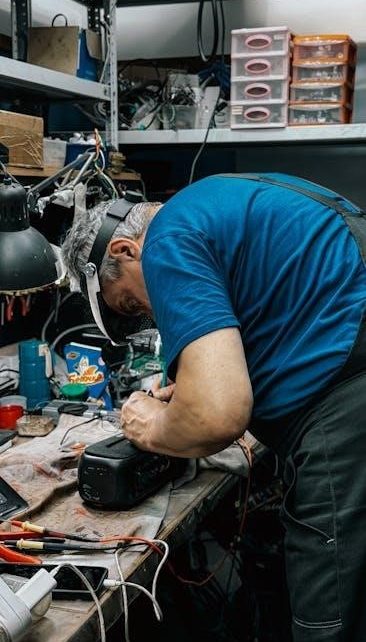Welcome to the comprehensive guide for the 2003 Ford Expedition fuse box diagram․ This resource provides detailed layouts, fuse locations, and troubleshooting tips for electrical systems․ Download the free PDF for easy access and ensure safe repairs with essential safety precautions included․
Table of Contents
- Fundamentals of the 2003 Ford Expedition Fuse Box
- Location of the Fuse Boxes
- Fuse Box Diagrams
- Troubleshooting with the Fuse Box Diagram
- Downloading and Using the PDF Diagram
- Electrical Systems Connected to the Fuse Box
- Safety Precautions When Working with the Fuse Box
- Role of Relay Boxes in the Electrical System
- Replacing the Fuse Box
- Maintenance Tips for the Fuse Box
- When to Seek Professional Help
- Frequently Asked Questions
- Resources for Further Reading
- References
This structured guide ensures a seamless navigation through the 2003 Ford Expedition fuse box diagram, providing essential information for troubleshooting, repairs, and maintenance․

Fundamentals of the 2003 Ford Expedition Fuse Box
The 2003 Ford Expedition fuse box is crucial for protecting electrical systems․ It includes fuses and relays, ensuring proper power distribution and circuit protection throughout the vehicle․
Components of the Fuse Box
The 2003 Ford Expedition fuse box contains essential components such as fuses, relays, and circuit breakers․ Fuses act as circuit protectors, interrupting power in case of overcurrent․ Relays handle high-current applications, like headlights and windshield wipers․ The fuse box also includes a power distribution center, organizing electrical circuits efficiently․ Each fuse is labeled with its respective amperage rating, ensuring easy identification․ These components work together to safeguard the vehicle’s electrical systems, preventing damage from surges or short circuits․ Proper maintenance of these elements is vital for reliable vehicle performance․
Functions of the Fuse Box
The fuse box in the 2003 Ford Expedition serves as the central hub for protecting and distributing electrical power․ It ensures each circuit operates within safe current levels, preventing damage from overloads․ By housing fuses and relays, it efficiently manages power distribution to various vehicle systems, such as lighting, wipers, and electronics․ In case of a short circuit, fuses act as sacrificial components, interrupting the flow to protect the wiring and connected devices․ This safeguarding function is crucial for maintaining the integrity and reliability of the vehicle’s electrical infrastructure․ Regular inspection of the fuse box is recommended to ensure optimal performance and safety․

Location of the Fuse Boxes
The 2003 Ford Expedition has two fuse boxes: one in the passenger compartment, located under the dashboard, and another in the engine compartment, on the driver’s side․ Refer to the diagram for precise locations and details․
Passenger Compartment Fuse Box
The passenger compartment fuse box in the 2003 Ford Expedition is located beneath the dashboard on the driver’s side․ It houses fuses for interior systems like the wipers, instrument cluster, and accessories․ The box is secured with screws and includes a cover with fuse labels․ For safety, always disconnect the battery before accessing it․ The diagram in the PDF guide provides detailed fuse assignments and layout, ensuring accurate troubleshooting and repairs․ Keep a copy handy to identify and replace fuses efficiently․
Engine Compartment Fuse Box
The engine compartment fuse box in the 2003 Ford Expedition is situated on the driver’s side of the engine bay, near the battery․ It controls high-current systems like the cooling fan, ABS, and fuel pump․ The box is weather-sealed and includes relays and high-power fuses․ The PDF diagram outlines each fuse’s function, aiding in quick diagnostics․ Always disconnect the battery before servicing to prevent electrical hazards․ Refer to the guide for precise fuse locations and ratings, ensuring safe and effective repairs to maintain your vehicle’s performance and reliability․

Fuse Box Diagrams
The 2003 Ford Expedition fuse box diagrams provide detailed layouts for both the passenger and engine compartments․ These diagrams identify fuse locations, functions, and circuits, aiding in quick troubleshooting and repairs․ Download the PDF guide for clear visuals and descriptions to ensure accurate diagnostics and maintenance of your vehicle’s electrical system․
Passenger Compartment Fuse Box Diagram
The passenger compartment fuse box diagram for the 2003 Ford Expedition outlines the layout and functions of each fuse․ It includes essential systems like the front wiper motor, instrument cluster, and tire pressure monitoring system․ The diagram provides clear labels and locations, making it easier to identify and replace fuses․ This section is crucial for diagnosing issues related to interior electrical components, ensuring proper functionality and safety․ Refer to the PDF guide for detailed visuals and descriptions to simplify your troubleshooting process․
Engine Compartment Fuse Box Diagram
The engine compartment fuse box diagram for the 2003 Ford Expedition details the fuses controlling essential engine functions․ It covers power distribution, fuel systems, and cooling components․ The diagram identifies each fuse’s role, aiding in quick troubleshooting of issues like faulty relays or blown fuses․ This guide ensures accurate diagnostics and repairs, preventing further damage․ By referencing the PDF, you can pinpoint the exact fuse locations and their purposes, streamlining maintenance and ensuring your vehicle runs smoothly․ Regular checks using this diagram help maintain optimal engine performance and reliability․

Troubleshooting with the Fuse Box Diagram
Use the 2003 Ford Expedition fuse box diagram to identify blown fuses and faulty relays․ Referencing the diagram ensures quick diagnostics and accurate repairs․
Common Issues Identified Using the Diagram
The 2003 Ford Expedition fuse box diagram helps identify common issues like blown fuses for the radio, wipers, or power windows․ It also reveals faulty relays affecting the fuel pump or ABS system․ By referencing the diagram, drivers can pinpoint which fuse corresponds to specific electrical components․ This prevents confusion when multiple fuses are blown or when symptoms point to multiple systems․ Additionally, the diagram aids in diagnosing why certain features, like the AC or instrument cluster, malfunction․ It ensures quick and accurate troubleshooting to restore functionality efficiently․
How to Use the Diagram for Diagnostics
To use the 2003 Ford Expedition fuse box diagram for diagnostics, start by identifying the symptoms of the issue, such as a malfunctioning radio or wipers․ Locate the corresponding fuse using the diagram, which maps each fuse to specific components․ Remove the suspect fuse using a fuse puller or tweezers and inspect it for a blown filament․ Replace blown fuses with ones of the same amperage rating, as indicated in the diagram․ Check related fuses for interconnected systems and refer to the diagram’s legend for symbols and notes․ After replacing a fuse, test the system to ensure functionality․ If issues persist, consider professional assistance․ Always disconnect the battery before starting work to ensure safety and prevent electrical hazards․
Downloading and Using the PDF Diagram
Download the 2003 Ford Expedition fuse box diagram PDF from trusted sources for a comprehensive guide to fuse locations and troubleshooting․ Easy to use and essential for repairs․
Where to Find the PDF
The 2003 Ford Expedition fuse box diagram PDF is widely available online․ Trusted sources include FuseCheck․com, Ford’s official resources, and forums like Ford Truck Enthusiasts․ You can also find it on platforms like Scribd or specialized automotive websites․ Ensure you download from reputable sites to avoid incorrect or incomplete diagrams․ Some forums and websites offer free downloads, while others may require registration․ Always verify the PDF’s accuracy to match your vehicle’s specifications for reliable troubleshooting and repairs․
Navigating the PDF Document
The PDF document is structured for easy navigation, typically starting with a table of contents or bookmarks․ Use the search function to locate specific fuses or systems quickly․ The diagram includes a legend explaining symbols and abbreviations․ Zoom in for detailed views of fuse locations and labels․ Many PDFs are interactive, allowing users to click on sections for direct access․ Print the document for hands-on reference while working on your vehicle․ Ensure your PDF viewer supports interactive features for the best experience․
Electrical Systems Connected to the Fuse Box
The 2003 Ford Expedition’s fuse box connects to essential systems like the front wiper motor, instrument cluster, and tire pressure monitoring system․ Each fuse powers specific components, ensuring electrical stability and proper functionality․
Understanding the Electrical Circuits
Electrical circuits in the 2003 Ford Expedition are organized into distinct systems, each protected by specific fuses․ These circuits power components like wipers, lights, and the TPMS․ The fuse box diagram identifies which fuses control which circuits, enabling precise diagnostics and repairs․ By understanding the layout, drivers can quickly pinpoint issues and replace the correct fuses, ensuring safety and functionality․ This structured approach simplifies troubleshooting, making it easier to maintain the vehicle’s electrical system effectively and efficiently․
How Fuses Protect the Electrical System
Fuses act as critical protective devices in the 2003 Ford Expedition’s electrical system․ They are designed to interrupt the circuit during an overcurrent event, such as a short circuit or overload, preventing damage to wiring and components․ Each fuse corresponds to a specific circuit, ensuring that only the affected area is disabled while other systems remain operational; This targeted protection allows for safe and efficient diagnostics, as a blown fuse identifies the problematic circuit․ Regular inspection and proper fuse ratings are essential to maintain this safeguarding function and prevent potential fire hazards․

Safety Precautions When Working with the Fuse Box
Always disconnect the battery before servicing the fuse box to prevent electrical shocks or short circuits․ Wear protective gloves and ensure the ignition is off․ Avoid improper fuse replacements and consult the diagram for correct fuse ratings․ Never touch electrical components with bare hands or tools that could cause damage․ Ensure proper ventilation and avoid sparks near flammable materials․ Follow the manufacturer’s guidelines and use authorized tools to maintain system integrity and safety․
Disconnecting the Battery
Disconnecting the battery is a critical safety step when working with the fuse box․ Locate the battery, typically in the engine compartment․ Always remove the negative (black) cable first using an appropriate wrench․ Secure the cable to prevent accidental contact․ This ensures no power flows through the electrical system․ Disconnecting the battery prevents shocks, short circuits, or unintended system activation․ It also allows the vehicle’s systems to reset․ Never touch electrical components without disconnecting the battery first․ Wait a few minutes after disconnection to ensure all residual power is discharged․ This step is essential for safe fuse box maintenance and repairs․
Avoiding Common Mistakes
When working with the fuse box, avoid common mistakes like not disconnecting the battery first, which can cause electrical shocks or damage․ Always identify the correct fuse using the diagram to prevent replacing the wrong one․ Avoid using the wrong tools, as this could damage the fuse box or fuses․ Never force a fuse into a socket, as it may break or cause poor connections․ Additionally, ensure the ignition and all accessories are turned off before starting work․ Properly secure tools and avoid touching electrical components unnecessarily․ These precautions help prevent accidents and ensure safe, effective repairs․

Role of Relay Boxes in the Electrical System
Relay boxes manage electrical circuits by directing power to components like lights and accessories․ They enhance system efficiency and protect against overloads, ensuring reliable performance․
Location and Function of Relay Boxes
In the 2003 Ford Expedition, relay boxes are typically located alongside the fuse boxes in both the passenger compartment and engine compartment․ Their primary function is to act as intermediate switches, controlling the flow of electrical current to various vehicle systems such as lights, wipers, and accessories․ By centralizing these controls, relay boxes simplify circuit management, enhance reliability, and reduce the risk of electrical overloads․ They work in conjunction with fuses to ensure safe and efficient operation of the vehicle’s electrical systems․
When to Replace a Relay
A relay should be replaced if it shows signs of failure, such as flickering lights, intermittent operation of electrical components, or complete loss of function․ Physical damage, burn marks, or a buzzing noise from the relay are also indicators․ If a fuse repeatedly blows or related systems malfunction, the relay may be faulty․ Always consult the fuse box diagram to identify the correct relay for replacement․ Ensure the vehicle is safe to work on by disconnecting the battery before performing any repairs or replacements․
Replacing the Fuse Box
Replacing the fuse box requires disconnecting the battery, using the PDF diagram to identify the correct box, and ensuring proper installation․ Tools include a wrench and new fuse box․ Follow safety guidelines for a secure replacement․
Tools and Materials Needed
To replace the fuse box, you’ll need a wrench for battery disconnection, a screwdriver for removing mounting screws, and pliers for disconnecting electrical connectors․ A new fuse box, compatible with your 2003 Ford Expedition, is essential․ Additional materials include electrical tape for securing wires and a multimeter to test circuits․ A torque wrench may be required for proper bolt tightening․ Safety gear like gloves and goggles is recommended․ Ensure all tools are readily available to streamline the replacement process․ Refer to the PDF diagram for specific part numbers and torque specifications to avoid errors during installation․
Step-by-Step Replacement Guide
Disconnect the negative battery terminal to prevent electrical shocks․
Remove mounting screws to access the fuse box․
Carefully pull the fuse box away from its bracket․
Disconnect all electrical connectors from the old fuse box․
Install the new fuse box, ensuring proper alignment․
Reconnect all electrical connectors securely․
Replace the mounting screws and tighten them firmly․
Reconnect the negative battery terminal․
Test all electrical systems to ensure proper functionality․
Refer to the PDF diagram for precise instructions and wiring details․
Maintenance Tips for the Fuse Box
Regularly clean corrosion from fuses and contacts․ Inspect for damaged or blown fuses․ Schedule periodic checks to ensure optimal electrical system performance and reliability․
Cleaning the Fuse Box
Cleaning the fuse box is essential for maintaining your 2003 Ford Expedition’s electrical system․ Start by disconnecting the battery to prevent power surges․ Remove the fuses and relays for access․ Use compressed air to blow out dust and debris․ For corrosion, gently scrub with a soft-bristled brush or cotton swab․ Avoid harsh chemicals․ Wipe clean with a dry cloth․ Reinstall components securely․ Regular cleaning prevents malfunctions and ensures reliable electrical performance․ Always refer to your fuse box diagram for proper identification of components during cleaning․
Regular Inspection Schedule
A regular inspection schedule for your 2003 Ford Expedition’s fuse box ensures optimal electrical system performance․ Check the fuse box every 6 months or 6,000 miles․ Inspect for signs of wear, corrosion, or blown fuses․ Use the fuse box diagram to identify and test each fuse․ Replace any damaged or corroded fuses promptly․ Clean connections and ensure all components are securely fastened․ Regular inspections prevent unexpected electrical failures and keep your vehicle running smoothly․ Refer to your owner’s manual or the fuse box diagram for a detailed maintenance plan tailored to your Expedition․

When to Seek Professional Help
Consult a professional if you encounter persistent electrical issues, multiple blown fuses, or complex problems beyond basic troubleshooting․ Experts ensure safe and accurate diagnoses and repairs․
Signs You Need a Mechanic
If you notice recurring electrical issues, blown fuses, or unexplained system malfunctions, it may indicate a deeper problem․ Persistent warning lights, power failures, or complex faults require professional attention․ A mechanic can diagnose underlying causes, such as faulty wiring or relay failures, ensuring repairs are done safely and effectively․ Don’t risk further damage or safety hazards—consult a certified technician for advanced troubleshooting and reliable solutions tailored to your 2003 Ford Expedition’s electrical system․
Professional Diagnostic Tools
Professional diagnostic tools are essential for accurately identifying issues in your 2003 Ford Expedition’s electrical system․ Tools like a multimeter and an OBD-II scanner help diagnose complex faults, while a fuse box diagram provides a clear map of circuits․ Advanced scan tools can pinpoint problems in the PCM or relay systems, ensuring precise repairs․ These tools are vital for mechanics to quickly identify and resolve issues, preventing further damage and ensuring safety․ They complement the fuse box diagram by providing real-time data for effective troubleshooting and reliable system restoration․

Frequently Asked Questions
Common questions about the 2003 Ford Expedition fuse box diagram include fuse locations, troubleshooting tips, and how to reset systems after repairs․ Download the PDF for detailed answers․
Common Questions About Fuse Issues
Common questions about the 2003 Ford Expedition fuse box diagram include identifying which fuse controls specific features like the radio or wipers, how to replace a blown fuse, and where to find the correct diagram․ Many users also ask about troubleshooting steps for electrical issues, such as why certain systems stop working․ Additionally, queries often arise about the difference between fuses and relays, how to reset systems after fuse replacement, and where to download a reliable PDF guide․ These questions highlight the importance of a detailed diagram for effective diagnostics and repairs․
Resetting Systems After Fuse Replacement
After replacing a fuse in your 2003 Ford Expedition, it’s essential to reset related systems to ensure proper functionality․ For example, the radio, lights, or other accessories may need to be reset or reinitialized․ Start by reconnecting the battery and testing each system individually․ If issues persist, consult the fuse box diagram to identify affected circuits․ In some cases, resetting the system may require turning the ignition on/off or performing a series of actions specific to the feature․ Always refer to the PDF guide for detailed instructions tailored to your vehicle․
Resources for Further Reading
Visit fusecheck․com for detailed fuse diagrams and troubleshooting guides․ Explore Ford Truck Enthusiasts Forums for expert advice and repair tips specific to your 2003 Ford Expedition․
Recommended Forums and Websites
For detailed insights and expert advice, visit fusecheck․com and explore the Ford Truck Enthusiasts Forums․ These platforms offer comprehensive guides, troubleshooting tips, and downloadable PDFs for the 2003 Ford Expedition fuse box diagram․ Additionally, websites like Ford Expedition forums provide user-generated content, repair experiences, and specific fuse-related discussions․ These resources are invaluable for DIY repairs and understanding complex electrical systems in your vehicle․
Additional Tools for Repair
Besides the PDF diagram, essential tools for repair include a fuse tester, multimeter, and torque wrench․ A fuse puller simplifies fuse removal without damage․ Wiring diagrams and circuit testers help pinpoint issues․ Torx screwdrivers and pliers are handy for accessing components․ A battery disconnect tool ensures safety during repairs․ These tools, available at auto repair stores or online marketplaces, enhance your ability to diagnose and fix electrical issues efficiently․ Always refer to the PDF guide for specific tool recommendations tailored to your 2003 Ford Expedition’s electrical system․
The 2003 Ford Expedition fuse box diagram is an invaluable resource for diagnosing and resolving electrical issues․ By understanding fuse locations and functions, owners can efficiently troubleshoot and repair systems․ Regular maintenance and proper tool usage ensure reliability and safety․ This guide, along with the downloadable PDF, equips you with comprehensive knowledge to manage your vehicle’s electrical system confidently․ For complex problems, consulting professional resources or a certified mechanic is recommended to maintain your Expedition in optimal condition․

References
For further assistance, refer to the official Ford Expedition owner’s manual and reliable online resources like FuseCheck․com․ Additional guides, such as the PCM Pinout from Ford Truck Enthusiasts Forums, provide detailed electrical system insights․ Websites offering free PDF downloads, like the ones mentioned, ensure accessible troubleshooting․ Always consult up-to-date sources for accurate fuse box diagrams and repair instructions specific to your vehicle’s model year․



